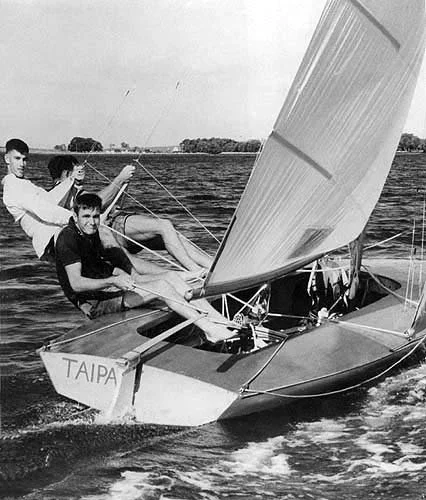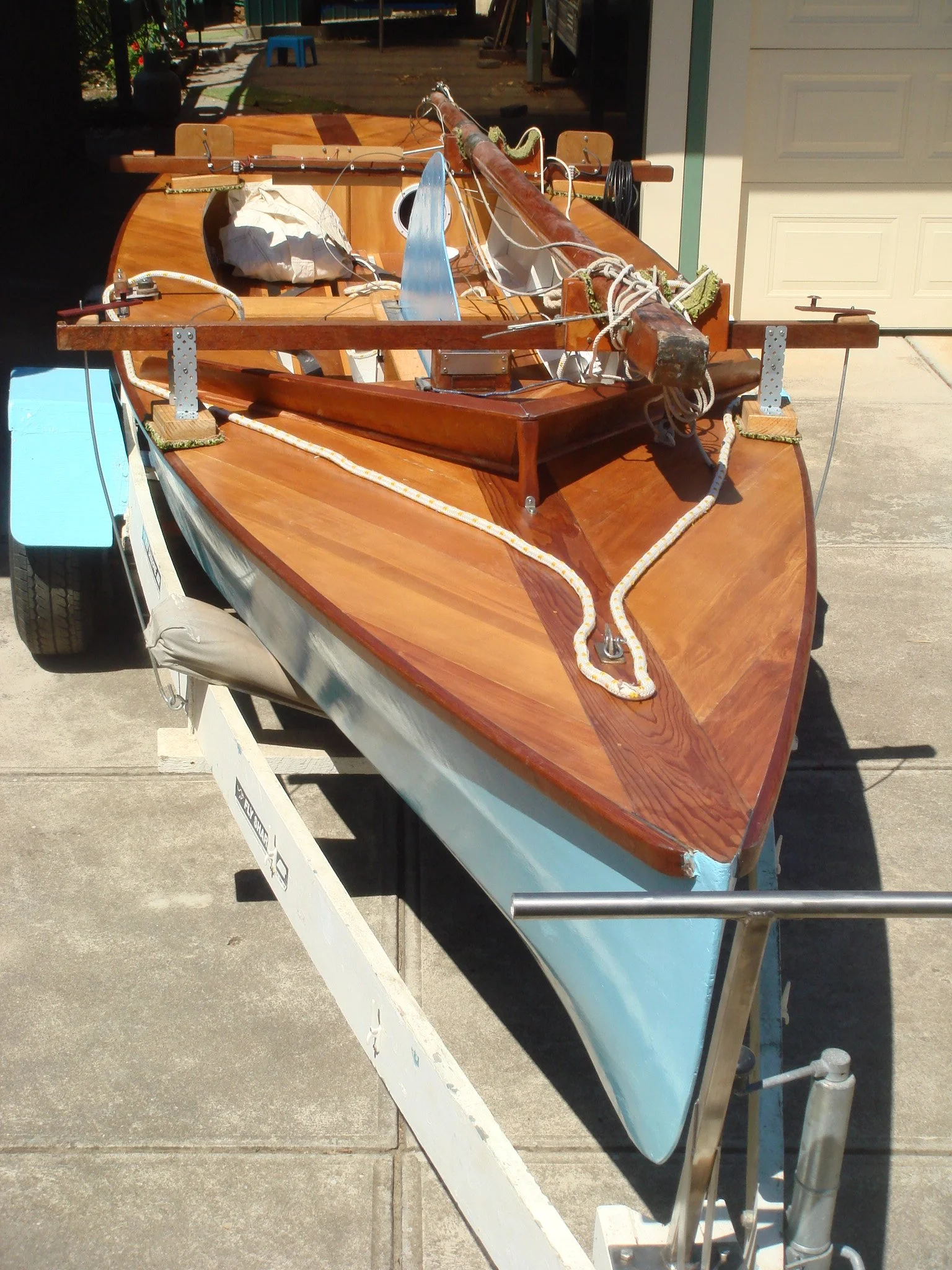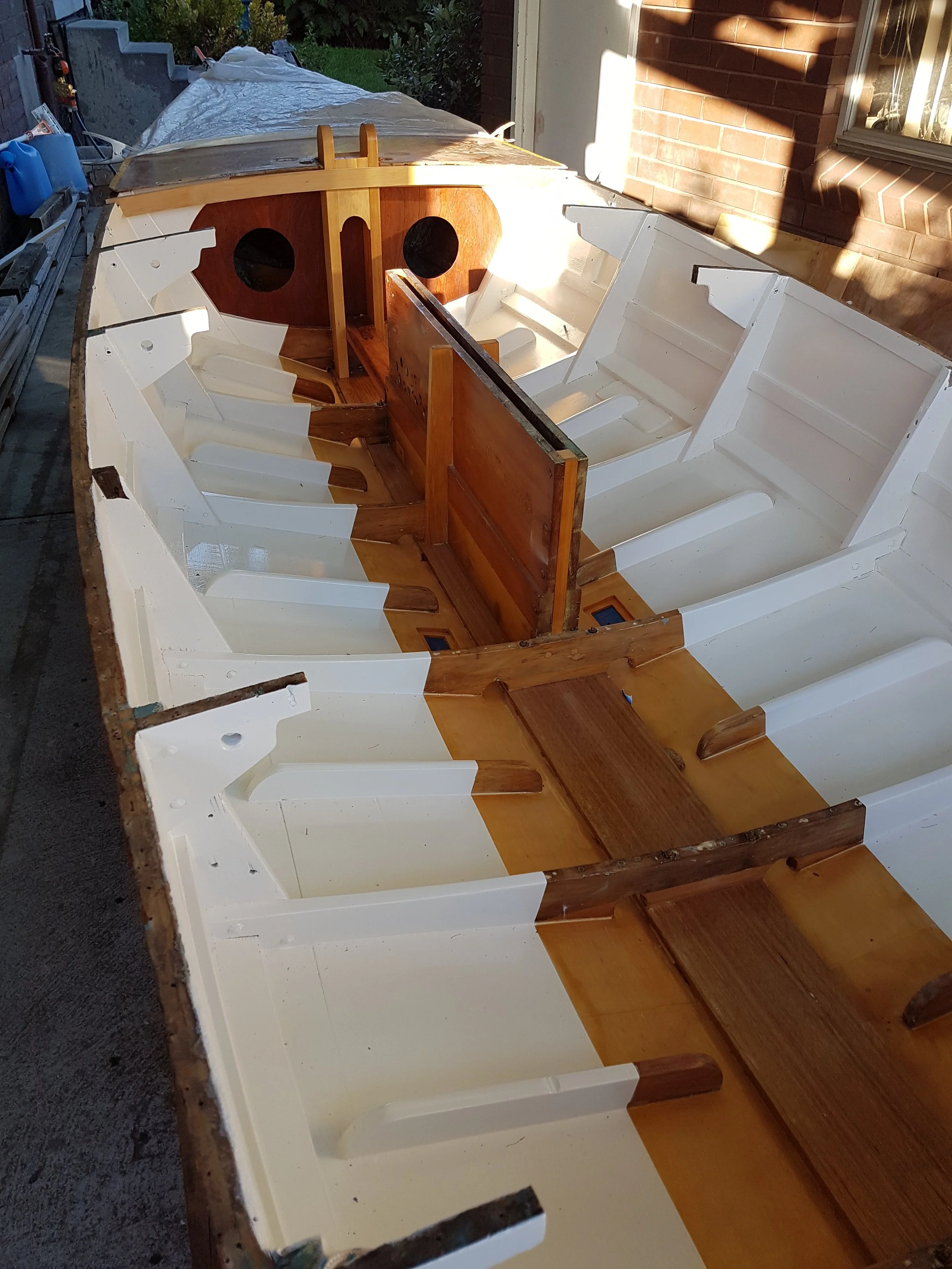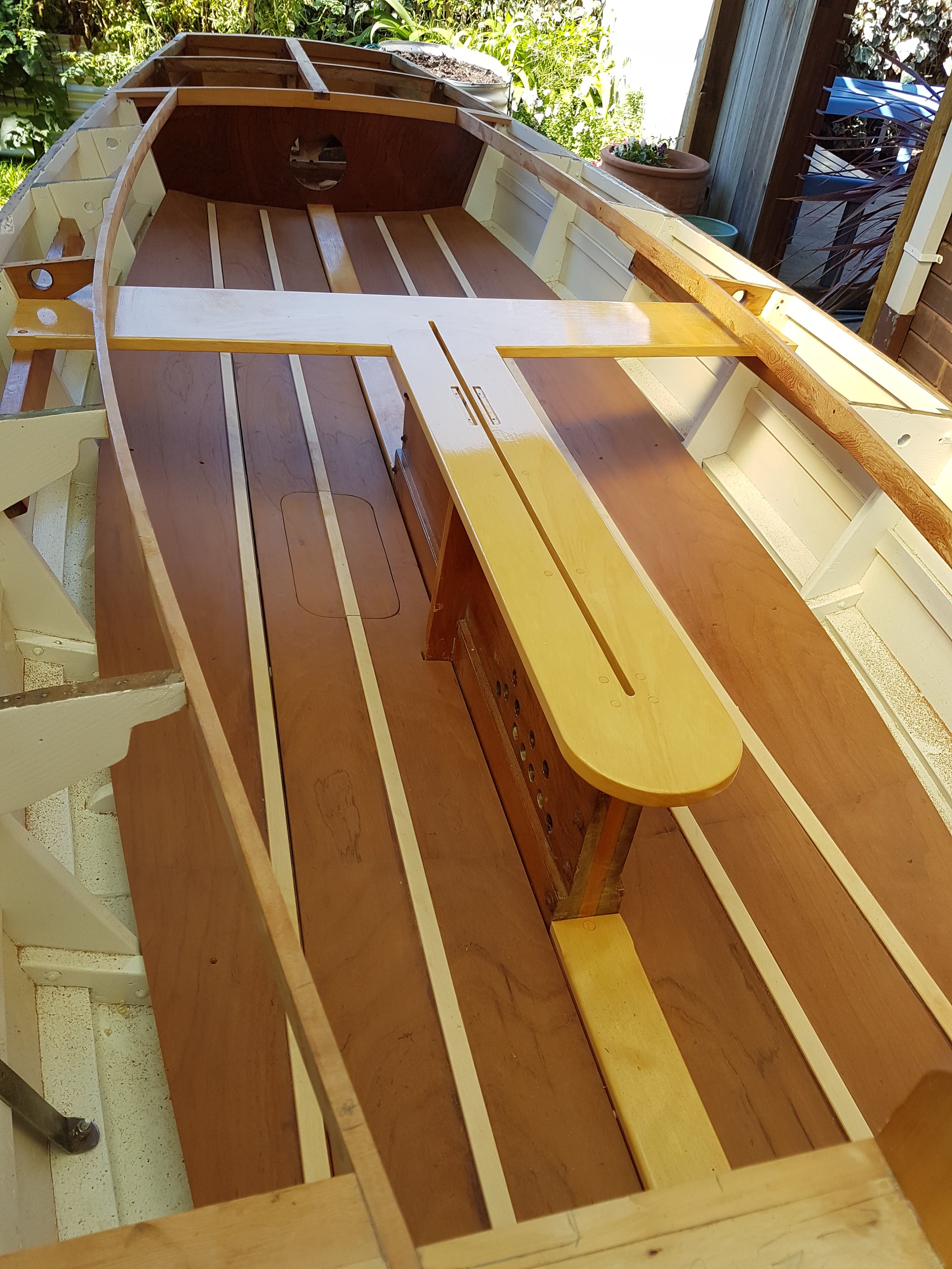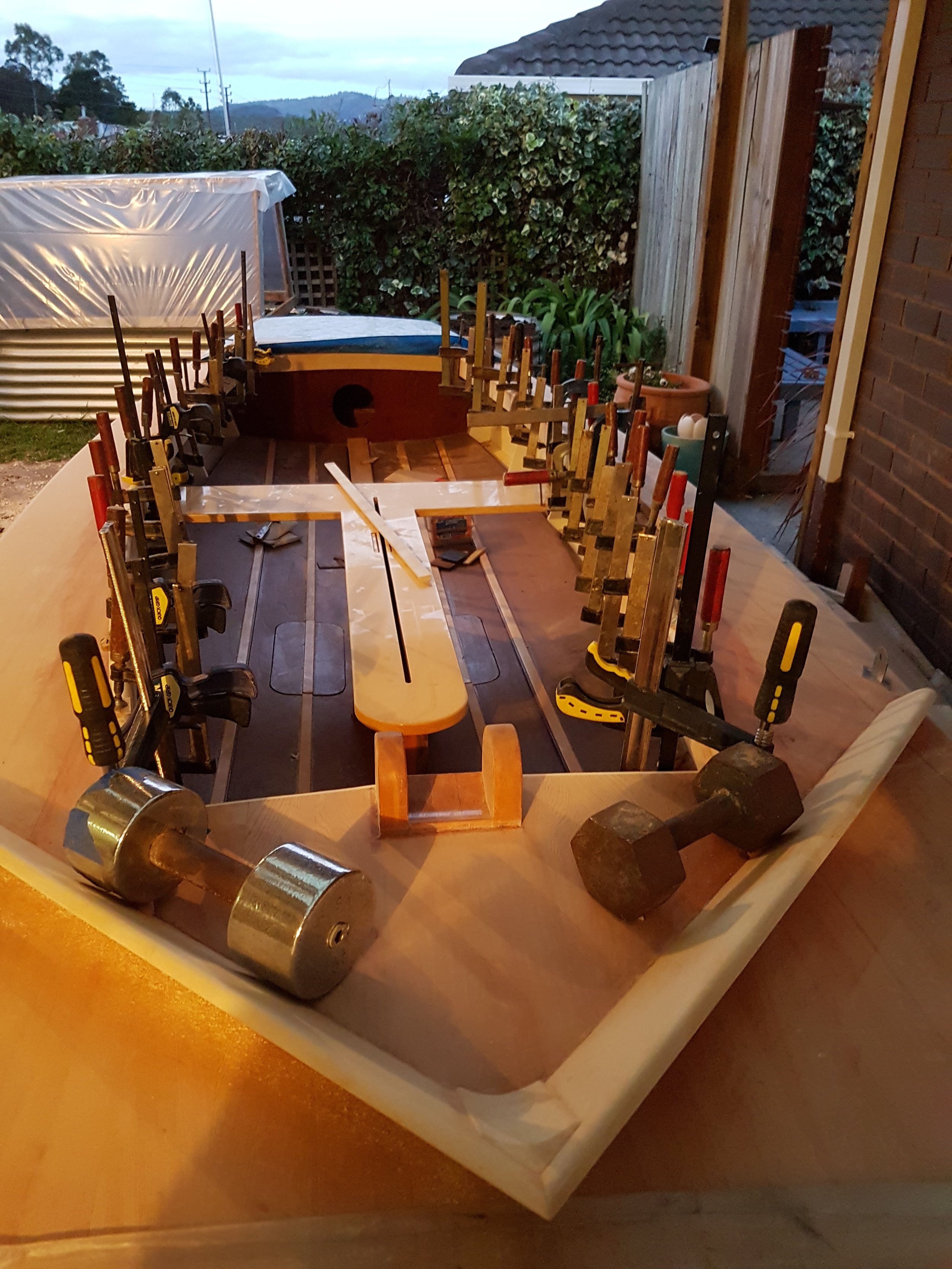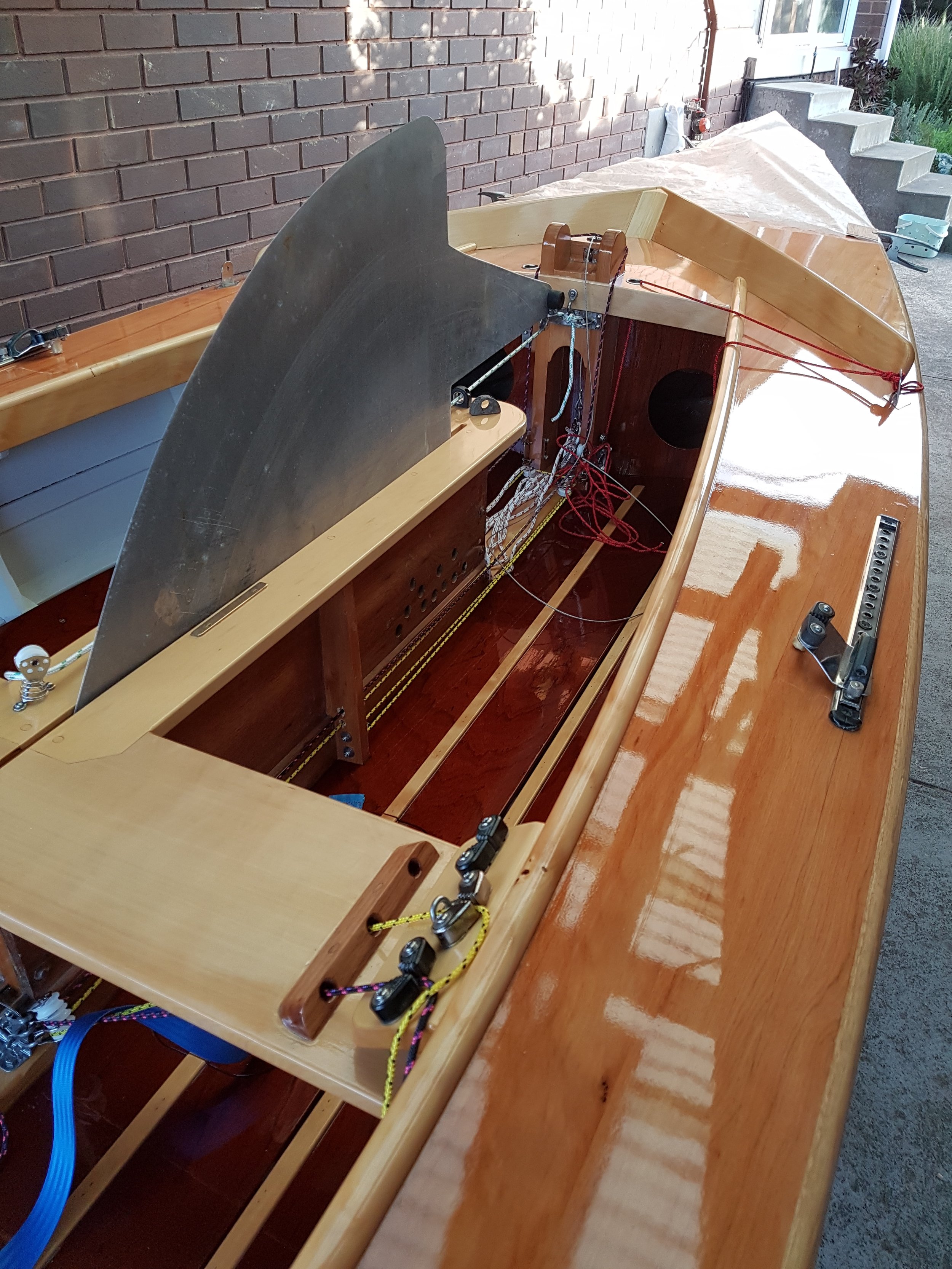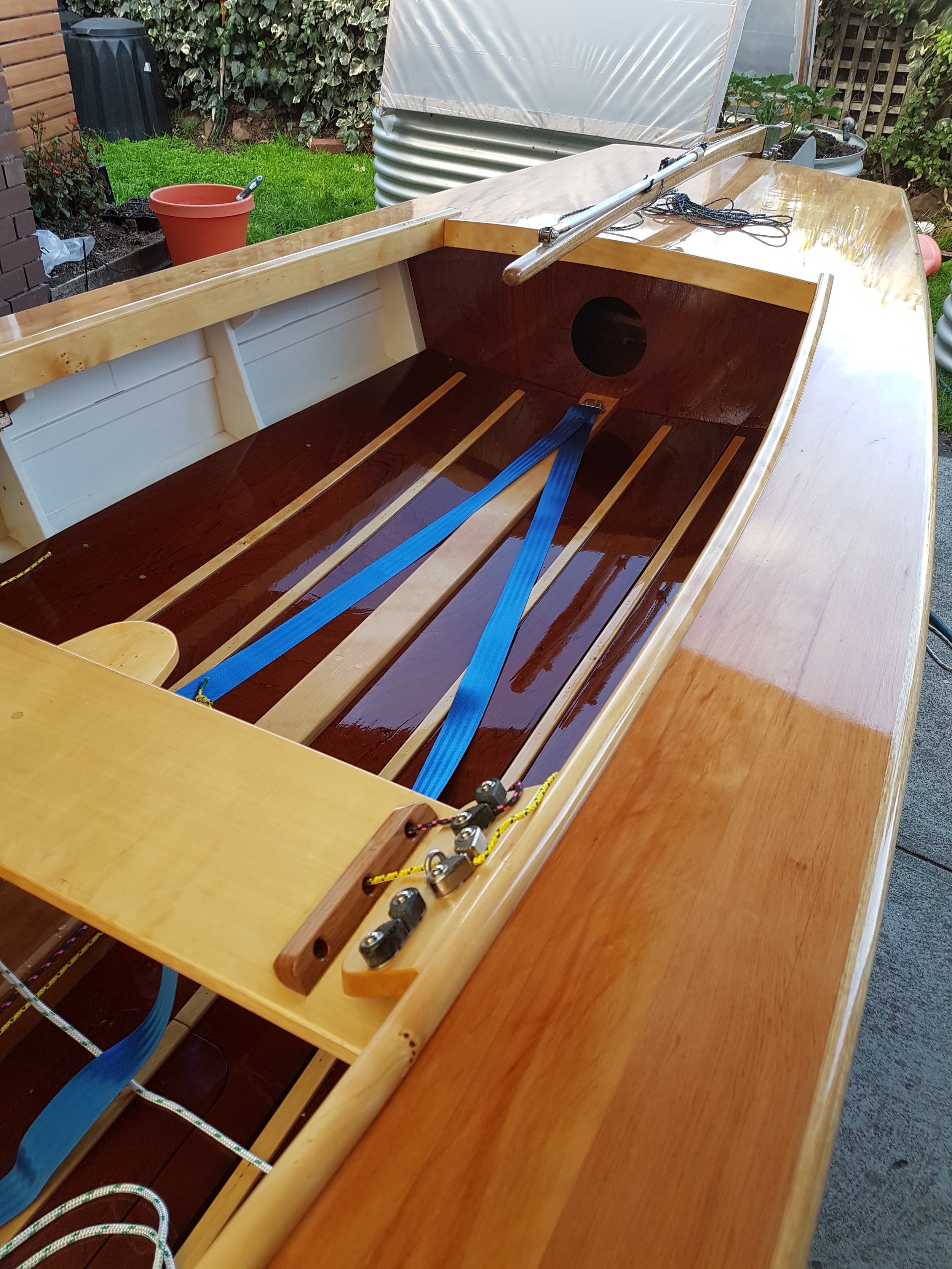The Sharpie Story - Saving Sabre
by Gordon Stewart with SWS
Restoration & Preservation
Restoration and preservation of maritime history is a philosophical and funding challenge. There are so many important boats that deserve attention. They connect to our pre and post settlement transport, trading, military and fishing heritage, others are associated with significant designers and sailors and there’s all the classes that made sailing into a national sport.
In 2006 the Australian National Maritime Museum launched an appeal for $100,000 ($150k today), ‘to restore the revolutionary 18 foot skiff TAIPAN conceived, built and sailed by design genius Ben Lexcen when he was just 23 years old. TAIPAN has a very important place in the history of Australian sailing. We are a Commonwealth agency and need supplementary funding for a lot of our restoration work said the Director of ANMM, Mary-Louise Williams’.
The museum cannot allocate funds for restoration work in its budget so still relies on external appeals. In the end Alan Bond, with a long personal connection to Bob Miller (Ben Lexcen), gave the money to restore TAIPAN to her original 1959 configuration. She has been sailed but is normally displayed in the foyer at Wharf 7 in Sydney. ANMM also hold Miller’s drawings and original sails from TAIPAN.
This story pretty much sets out the situation. The immediate problem is prioritising what to preserve, who pays and who does the work. There is certainly a public responsibility but lack of funding means recovery relies on haphazard donations, charities but mostly privateers.
18ft Skiff TAIPAN. Drawings by Bob Miller: Collection ANMM
Public museums prefer formal displays (with programmed dusting) that maximises access while privateers prefer to restore AND sail their boats. TAIPAN has no monetary value but is an important 18 foot skiff worthy of museum status, demonstrating Bob Miller’s design pedigree.
Heavyweight Sharpies have also achieved museum status. Jim Hardy’s TINTARA is restored and held by the SA Maritime Museum in Port Adelaide. This is about Hardy’s history as an Australian Sharpie champion in the 1950’s, an Olympian in the 1960’s and America’s Cup helm in the 1970’s.
Following SWS The Sharpie Story - Finding Sabre, the three 1956 Olympic medal boats are all in private hands and in various states of restoration. Peter Mander’s JEST and her stablemate QUEST are in Nelson South Island NZ. From 2018 photos she’s ready to paint and rig. Rolly Tasker’s Australian HW Sharpie FALCON III & his Olympic Sharpie FALCON IV are being restored privately. The UK bronze medallist CHUCKLES is fully restored and sailing again near Norfolk on the SE English coast. (click on images to enlarge)
Maritime Museums
The collective archives of our nation are suffering slow strangulation by lack of commitment and funding. The reasons for preservation are obvious. The National Library of Australia, the National Museum, the National Film & Sound Archive and State Maritime Museums are struggling. Collections are deteriorating and large parts remain undigitised. Archivists, researchers and librarians have been sacked and if retained have been ironically rebranded as Knowledge Keepers or Navigators.
By contrast, funding allocated to a massive extension of Canberra’s War Memorial says much about the mind shape of recent government, attracted to military institutions and structures. Typically Customs was rebranded as Border Force (also a TV show with a lucky vowel). While chastising and defunding these protectors of cultural heritage, LNP governments have stacked their boards with political appointees who understand little of the task and fail to promote, defend or seek funding. There’s no surprise in political offers of board seats, but whats truely galling is the hubris of acceptance. One nice guy LNP hack from FN Queensland, sits on the board of the National Film & Sound Archive. His ‘lived experience’ declared in governance on the NFSA website, is as an auctioneer and motor vehicle franchiser in Townsville. Australians love our Homes-n-Holdens and this appointee could well be a movie buff as Gideon Haigh noted*. Maybe he’s an expert on Ginger Meggs?
There was a rush to build maritime museums in the 1980’s after AUSTRALIA II’s Americas Cup win. Several extravagant white curving crustaceans associated with dockland redevelopments were delivered. There was the Australian National MM in Darling Harbour, a West Australian MM in Fremantle and a purpose built MM in Townsville. The Maritime Museum of Tasmania started much earlier with private collections at the back of a Battery Point church. It now occupies a grand brick pile, the Carnegie Building near Constitution Dock. Curious but no doubt welcome at the time, this was originally the Hobart Public Library, funded by American philanthropist Andrew Carnegie.
In Victoria maritime preservation survives on voluntary efforts and donations. There are boats to visit in Melbourne like Polly Woodside and the tug Wattle at Docklands. Alma Doepel is a coastal transport schooner being restored nearby and HMAS Castlemaine, a WW2 Corvette in Williamstown is run by a charity based Maritime Trust. There are also many small local museums like at Queenscliffe. This was privately established to preserve the last lifeboat that saved many seamen and fishermen at Port Phillip Heads, better known as the Rip.
SWS, while never claiming perfect sourcing, regularly relies on these institutions. Trove, ANMM and the very excellent staff and website of the Maritime Museum of Tasmania underpin our research and stories charging modest fees.
No Votes in Boats
Public funding of maritime preservation cannot solve the problem. Like most enterprises in Australia, there is no point waiting for a reset of government policy and funds to flow. As usual, community groups, charities, trusts and wealthy individuals (with time or money) do the heavy lifting. There’s no votes in boats.
It’s the privateers that are saving the dinghy classes. The Australian Classic Dinghy Network, founded by John Fairfax is a loose group of wood-nuts dedicated to restoring classic dinghies and sharing archive information and photos. These are sailors with time and skill who grew up in the 1960’s and 70’s sailing dinghies. It’s often driven by nostalgia or finding theirs or their old-man’s axe. In Victoria you can regularly see the beautifully restored HW Sharpie CHEYENNE at classic regattas. She’s museum quality but the owner prefers an active sailing archive. You could have recently purchased your own museum piece. The 1947 HW Sharpie SEA ROVER, complete with Tasker cotton sails for $2,800.
The 2nd Stewart Sharpie
Gordon Stewart relives his childhood at Frankston and Phillip Island here in Part 2 of The Sharpie Story - Saving Sabre.
SABRE hitched up and heading home to Hobart 2015.
I don’t remember exactly what drew me to the idea of finding a 12 Square Metre Sharpie but it was no doubt a bit of nostalgia around my father’s boat and early family sailing experiences. I also stumbled across photos and videos on the internet of Sharpies sailing in the UK and Europe. With my boatbuilding skills and newly found spare time, I figured there must be an old 12 Square Metre Heavyweight out there needing restoration.
The AWBF kindly posted a notice in their newsletter - ‘Looking for Heavyweight Sharpie to restore and sail’. The first response was from Sydney offering a restored ZENA. Not really what I was looking for as my preference was to save one. The second response was from Wagga Wagga in southern NSW. I didn’t know they had a navigable piece of water, never mind a sailing club. How a HW Sharpie ended up in Wagga Wagga, a city that sits on the Olympic Highway named to honour the torch route to Melbourne 1956.
In the early 1960’s the Wagga Wagga Sailing Club was looking for new class of boat to boost their fleet. With Lightweight Sharpies taking over, there were old HW Sharpies being abandoned. So old Melbourne HW’s migrated north to Wagga Wagga to build a fleet of twelve boats. The last one was sailing there until the 1980’s. SABRE was the only survivor, sitting in a garage for a decade or two.
In 2015 I planned a road trip that took us to Longreach in outback Queensland. To my wife’s surprise our route included a diversion via Wagga Wagga where my motives soon became clear. I wasn’t sure what to expect but SABRE was complete and in fair sailing condition. My budget was something less than $0.00. Anyway, with vendor generosity subtracted from the price, we found ourselves returning via Wagga Wagga and towing a newly acquired maritime artefact back to Hobart.
I did a bit of research about SABRE’s history. She had likely come to Wagga Wagga from the Mordialloc 12 Square Metre Sailing Club, only 12 minutes or seven stations north of Kananook where I grew up. I then found newspaper articles from the 1950’s on Sharpie racing. The only boat named SABRE was built and raced by Don Muir from Hobart around 1953. Don was Jock Muir’s younger brother. He had already built other Sharpies in the Muir family boatyard at Battery Point - TAWAKI and KITTYHAWK in 1949 and SKIMMER and DARTER in 1950. That seemed to fit with her bottom planking of Huon Pine. Not conclusive, but I liked that SABRE was probably Tasmanian. I was able to finally confirm her provenance when old Hobart Sharpie sailors who knew the boat from the 50’s, recognised several distinguishing features. The cove line and embellishments were classic Don Muir signatures, identical to SKIMMER. Shipwright Sam Purdon recalled selling the Oregon planking for SABRE’s topsides to Don Muir. So now its settled STEWART is the Tassy immigrant and SABRE is the true local.
Restoration
While thinking about the work required on the hull, I started stripping back the spars for revarnishing. The gaff, boom and spinnaker pole were all in good condition for their age and came up well in no time. The mast was opening up along the seam joining the two hollow halves of Oregon. After cleaning out the old glue and applying plenty of epoxy, the spar was re-joined ready for varnish. (click images to enlarge and tab right)
SABRE was in a sailable condition. With a small amount of damage to the ply deck repaired, she could hit the water. However, I really wanted to give her a real spruce-up. Initially I thought to replace the old ply deck, fit new gunwales, scrape sand and repaint and I’d be off sailing. I should have known better - boats are never that simple.
After building a temporary roof adjacent to my small workshop we carried SABRE to the new ‘Sharpie Shelter’. Did I mention Sharpies are VERY heavy? I started by removing the old ply deck which came away without trouble. I was then able to assess the condition of the hull and frames. Under the forward and aft buoyancy tanks the hardwood keel had rot. The damage could have been locally repaired but the real problem was the garboard planks. They had worked out of the keel rabbet and the keel had several splits along the line of garboard fastenings of clenched copper nails. This committed me to a proper rebuild. (click images to enlarge and tab right)
This slow deterioration probably occurred gradually as a result of the local climate and irregular sailing. Wagga Wagga has hot dry summers and very cold winters, not ideal for a traditionally planked hull. SABRE’s plank seams had been filled with an elastic Sikaflex type compound. In any case, SABRE had survived while others didn’t. The keel and garboards would need to come out and be replaced. A suitable piece of Tasmanian Blue Gum was sourced for the new keel followed by a trip to a west coast mill to source new Huon Pine planking for the 14mm garboards. I was on a roll so added some Huon for the thwart, centre case capping, transom, coamings and deck trim. With the work ahead, I was not holding back on a special restoration.
After bracing the hull, the centre-plate case was removed, the hull rolled over, levelled up and secured so that the garboard planks, keel and transom could be removed. The old paint was stripped and the Sika seams milled out ready for splining. A new keel was shaped and secured in place. A new transom was fitted and the 14mm Huon garboard planks steamed, fitted and fastened. The centre-plate case was rebuilt using the original timbers and refitted to the keel. The hull was now back in one piece. King Bill Pine splines were driven home allowing the hull to be faired and finished before rolling upright ready for a new deck. The hull was painted with yellow below the waterline and clear finished topsides.
I happened to chat with a Tasmanian boating identity and ex HW Sharpie sailor John Lucas. John had sailed with SABRE’s builder Don Muir in Hobart during the 1950’s. When I told him I was restoring SABRE he recalled his most vivid memory of her yellow hull. To keep the tradition, I finished the hull below the waterline in bright yellow but chose to keep the battle-scarred Oregon topsides clear finished.
I was also introduced to fellow shipwright and Sharpie custodian Terry Lean. He was completing restoration of the last Tassy built Sharpie JABIRU. Terry had already re-decked with book matched 10mm King Billy. The result was superb inspiring me to follow his lead.
Whilst waiting for my order of King Billy deck timber, I finished scraping the paint from the internal hull and framing. I now had a clean surface for refinishing. Not quite up to clear finishing in the cockpit, but I did keep the inside of the new Huon garboards and keel timber clear. You can’t see these once the bottom boards are in place, but I know they are there.
Framing for the side decks was re-built, a new deck beam fitted and Australian Cedar ply bulkheads installed. All internal surfaces were treated with five coats of epoxy preservative under the white paint. Terry helped mill the King Billy decking on his bandsaw then dress it to 11mm. By the time the planking was glued, faired and epoxy applied underside, I have a 10mm deck. Under International 12 Square Metre rules the deck should be 14mm Mahogany. The 1935 South Australian rules called for 3/8” Spruce fastened with brass screws. By 1956, Australian rules allowed 10mm plywood. I figured given the mix of rules and that SABRE is never likely to meet a class measurer, my 10mm King Billy is good. It achieves a balance of compliance, practicality, aesthetic appeal while using endemic Tassy timbers. After final fitting of gunwales, cockpit trims, splash boards and a new set of cockpit bottom boards, the boat received her final coats of varnish ready for fittings. (click images to enlarge and tab right)
SABRE’s rig is a mix of new and old. I wanted reliable running rig while retaining original fittings where possible (or at least fittings from the era). I drew inspiration from the European Sharpies which have kept their traditional hulls and spars blended with modern fittings. This is a good approach balancing period and contemporary gear that contributes to the survival and these classic classes and encourages them to be sailed again. I’m not alone in conceding that some original fittings simply don’t work as well as new ones. I’ve found myself replacing old cam cleats with modern ones and changing old stainless blocks for modern blocks with bearings.
SABRE and JABIRU ordered new sails from Doyle Sails at Battery Point. In a neat bit of Chinese number magic I was able to reverse SABRE’s Wagga Wagga #83 to her original #38 sail number. Terry was already fixing a second HW Sharpie SKIMMER, the Don Muir boat built for Tasmanian yachtsman Ediss Boyes. He sailed SKIMMER to win the Australian Championship held in Brisbane in 1951. SKIMMER had some restoration work by previous owners and was in sailing condition. By the 2017 sailing season, we were ready to re-launch three Australian 12 Square Metre Heavyweight Sharpies. (click images to enlarge and tab right)
Launching a Heavyweight
Port Cygnet Sailing Club Opening Day 2017 was venue set for re-launch. Amongst the chaos of the carpark, the three Heavyweight Sharpies SABRE, JABIRU II and SKIMMER were rigged. A few old Sharpie sailors came along, including Mick Purdon who built JABIRU in 1959 with his brother Sam. It was overcast with a very light northerly, perfect for a first sail. After the sail-past we had a short race. I can’t remember the result but pretty sure JABIRU took the honours. It felt like a great milestone in the history of the class to see these three craft on the water together. Probably the most Heavyweight Sharpies on the water at the same time in Tasmania in more than five decades.
Terry Sailed JABIRU out of Port Cygnet several times that first season then sold her to yachtsman and boat builder Ian Johnston who sails her regularly around Southern Tasmania. Terry has SKIMMER in his workshop giving her the same terrific treatment that JABIRU received. Once about complete SKIMMER will be looking for a new custodian. Terry has too many projects on the go.
Sailing a Heavyweight
I sail SABRE regularly at Port Cygnet SC with Roger Masters. We sail her two up, taking turns on the helm. We persisted without the spinnaker or trapeze in true International 12 Square Metre Sharpie style. The Heavyweight has proven very forgiving to handle in big blows. After resisting for some time, we added the trapeze. This has been a revelation. Our righting moment and performance has vastly improved and it’s more comfortable than old school hiking up forward. The centre-plate capping sits so close to the inboard deck, making it difficult to stretch out in an efficient and comfortable hiking position.
SABRE is hard work up wind and difficult to point compared to more modern boats. The Etchells 22’s we race against kill us to windward, especially when its light. They are about 15 minutes faster around a 90 minute course. Downwind we can just about keep up. The HW Sharpie without steel rudder and centre-plate, bottom boards, sails and rigging is 230Kg. Sailing weight with crew and all gear is around 500Kg. Getting one of these beasts to plane is a rare event but when they do, you know about it.
Traditionally, the Australian HW Sharpies carried two spinnakers. A balloon for running and a flatty for reaching. We run a single kite that measures to the balloon but with a modern fabric and cut, making it perfect for most of the shy work. Steve Walker Sails in Wynyard Tasmania made SABRE’s new kite. Steve has a long dinghy racing and sail making background. He has been involved in Mirror sailing since the 1980’s as coach to Mirror teams and also producing tuning guides. (click images to enlarge and tab right)
Tasmanian Sharpies
The first 12 Sq Metre Sharpie to arrive in Tasmania was GULL. She was purchased by George Peacock from Adelaide in 1935. To establish the class four were ordered from the Taylor Bros at Battery Point in 1936. From 1937 to 1959, fifty-seven 12 Square Metre Sharpies are known to have been built in Tasmania. Don Muir of the family boatbuilding dynasty built at least five. JABIRU II was the last one in 1959, built by the boatbuilding brothers Mick and Sam Purdon.
Four 12 Square Metre Sharpies being made to order at Taylor Bros. Battery Point Hobart 1936. Photo: Maritime Museum of Tasmania
The Future
The last time HW’ and Lightweight Sharpies sailed a combined National Championship was in Hobart 1961 - ‘62. This coming summer 2022 -’23, Australian Lightweight Sharpies are holding their Nationals at the Derwent Sailing Club in Hobart. There are plans to run a short series for the Heavyweights alongside the lighter, sportier sisters. SABRE and JABIRU will participate and hopefully the recently discovered SKUA. If SKIMMER finds a new custodian, she could make it too. There are about six or seven sailable Heavyweights around the country. It would be nice to think that a few might make the journey to Hobart but given the distances and cost of transport across Bass Strait on the Spirit of Tasmania, it seems unlikely.**
Perhaps in the future, we might be able to arrange a HW Sharpie Championship at one of the many classic dinghy regattas. I have thought about travelling to Europe, chartering a HW Sharpie and do a Championship. We’ll have to think about that one?
We’re committed to sailing SABRE out of Cygnet for the foreseeable future. After four seasons of racing, she’s received a revarnish and spruce up. The average age of the crew is 60 and SABRE is 70 next year. She’s a heavy brute to handle ashore and takes twice as long to rig, launch and recover compared with a modern dinghy. However, it’s a real privilege to sail a boat like SABRE.
We have huge respect for early Sharpie sailors from the 1930’s. We get a real buzz out of sailing a beautiful classic, especially when reaching under the kite while passing modern racing boats. We reckon SABRE will still be gong long after we retire.
Sabre’s Specifications
Class: Australian 12 Square Metre Sharpie (Heavyweight)
LOA: 5.99m (19’ 7 ¾”)
Beam: 1.43m (4’ 8 5/16”)
Hull weight: 230kg with fittings. Ex rudder, centre-plate, bottom boards, sails and rigging.
Rig: Gunter
Sail area: 12m2 (130 sq feet) working sails plus spinnaker
Builder: Don Muir Battery Point, Hobart. Year launched: 1953
Frames: Celery Top Pine and Tasmanian Oak
Hull: Huon Pine bottom planking. Douglas Fir (Oregon) topsides. 14mm
Deck: King Billy Pine. 10mm
Spars: Douglas Fir (Oregon)
Credits
The author Gordon Stewart lives in Hobart and sails his 12 Square Metre Sharpie SABRE from Port Cygnet Sailing Club.
Unless noted, all photos are from Gordon’s archive. SWS has attributed where possible. The source of many images is a work ‘on progress’
Lead Photo: SKIMMER and JABIRU with MAORI LASS behind in Wilson’s Boatyard shed, Cygnet Tasmania. Photo: Terry Lean
Information on Tasmanian Sharpies relies on documents compiled by maritime historians Nicole Mays and Graeme Broxam.
Industrious, Innovative, Altruistic: 20th Century Boat Builders of Battery Point. Nicole Mays, Navarine Publishing 2017. NLA Catalogue ISBN: 978-0-9923660-5-6
* Gideon Haigh. Neglected Heritage. The Australian 18 June 2022
** The Spirit of Tasmania is underwriting travel costs for classic dinghies participating in the Australian Wooden Boat Festival in Hobart 10-13 February 2023. Contact AWBF for details.


